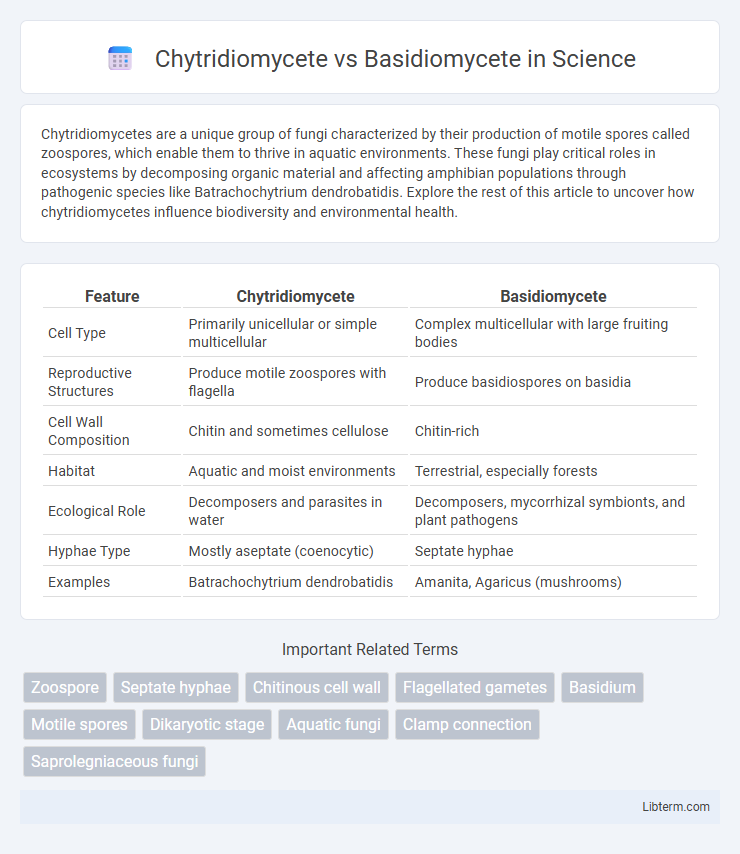Chytridiomycetes are a unique group of fungi characterized by their production of motile spores called zoospores, which enable them to thrive in aquatic environments. These fungi play critical roles in ecosystems by decomposing organic material and affecting amphibian populations through pathogenic species like Batrachochytrium dendrobatidis. Explore the rest of this article to uncover how chytridiomycetes influence biodiversity and environmental health.
Table of Comparison
| Feature | Chytridiomycete | Basidiomycete |
|---|---|---|
| Cell Type | Primarily unicellular or simple multicellular | Complex multicellular with large fruiting bodies |
| Reproductive Structures | Produce motile zoospores with flagella | Produce basidiospores on basidia |
| Cell Wall Composition | Chitin and sometimes cellulose | Chitin-rich |
| Habitat | Aquatic and moist environments | Terrestrial, especially forests |
| Ecological Role | Decomposers and parasites in water | Decomposers, mycorrhizal symbionts, and plant pathogens |
| Hyphae Type | Mostly aseptate (coenocytic) | Septate hyphae |
| Examples | Batrachochytrium dendrobatidis | Amanita, Agaricus (mushrooms) |
Introduction to Chytridiomycetes and Basidiomycetes
Chytridiomycetes are a primitive group of fungi characterized by their production of motile zoospores with flagella, primarily aquatic and playing crucial roles in decomposing organic matter in freshwater environments. Basidiomycetes represent a diverse group of higher fungi distinguished by their production of basidiospores on specialized structures called basidia, encompassing mushrooms, puffballs, and shelf fungi that are key decomposers of wood and leaf litter. Both groups differ significantly in reproductive mechanisms and ecological roles, with chytrids exhibiting flagellated spores and basidiomycetes undergoing complex sexual reproduction and forming elaborate fruiting bodies.
Taxonomic Classification of Chytridiomycetes and Basidiomycetes
Chytridiomycetes belong to the phylum Chytridiomycota, characterized by their production of motile zoospores with a single posterior flagellum, distinguishing them in fungal taxonomy. Basidiomycetes are classified under the phylum Basidiomycota, defined by their formation of basidia, specialized spore-producing cells typically bearing external basidiospores. These fundamental differences in reproductive structures and zoospore motility serve as key taxonomic markers separating Chytridiomycetes from Basidiomycetes in fungal classification systems.
Morphological Differences
Chytridiomycetes are primarily unicellular or simple filamentous fungi with motile spores featuring flagella, while Basidiomycetes form complex multicellular structures, including dikaryotic mycelia and fruiting bodies called basidiocarps. Chytridiomycete cell walls typically contain chitin and glucans but lack the extensive septation found in Basidiomycetes, which have septate hyphae with clamp connections. The reproductive structures differ significantly: Chytridiomycetes produce zoospores in sporangia, whereas Basidiomycetes generate basidiospores on external basidia located on the gills or pores of mushrooms.
Life Cycle Comparison
Chytridiomycetes exhibit a simpler life cycle characterized by the production of motile zoospores with flagella, facilitating aquatic dispersal, and often alternate between haploid and diploid stages through asexual and sexual reproduction. Basidiomycetes demonstrate a more complex life cycle involving the formation of basidiospores on specialized structures called basidia, featuring prolonged dikaryotic phases and plasmogamy preceding karyogamy and meiosis. The distinct reproductive strategies and spore dispersal mechanisms underscore the evolutionary divergence between Chytridiomycetes and Basidiomycetes within the fungal kingdom.
Reproductive Strategies
Chytridiomycetes reproduce primarily through the production of motile zoospores that utilize flagella for aquatic dispersal, enabling successful colonization in moist environments. Basidiomycetes employ sexual reproduction via specialized cells called basidia, which produce non-motile basidiospores on external structures like mushrooms or brackets, facilitating aerial spore dispersal. The contrast in reproductive strategies between the motile zoospores of Chytridiomycetes and the airborne basidiospores of Basidiomycetes reflects adaptation to different ecological niches and dispersal mechanisms.
Habitat and Ecological Roles
Chytridiomycetes primarily inhabit aquatic environments and moist soils, where they function as decomposers breaking down complex organic materials such as chitin and keratin. Basidiomycetes are predominantly terrestrial fungi found in forests, grasslands, and decaying wood, playing crucial roles as decomposers of lignin and cellulose and forming mutualistic mycorrhizal associations with plants. Both groups significantly contribute to nutrient cycling, but Chytridiomycetes excel in aquatic nutrient turnover while Basidiomycetes dominate terrestrial ecosystems in organic matter decomposition.
Cellular Structure and Key Organelles
Chytridiomycetes possess simple, often unicellular structures with flagellated zoospores containing a single posterior flagellum, distinguishing them with motile reproductive cells. Basidiomycetes exhibit complex multicellular organization characterized by septate hyphae with clamp connections and prominent basidia as key organelles responsible for sexual spore production. The cellular structure in Basidiomycetes supports advanced nutrient transport and specialization, contrasting with the more primitive and aquatic-adapted architecture seen in Chytridiomycetes.
Pathogenicity and Economic Importance
Chytridiomycetes are primarily aquatic fungi known for their pathogenicity in amphibians, notably causing chytridiomycosis, which has led to significant ecological disruptions and biodiversity loss. Basidiomycetes include many economically important species such as edible mushrooms (Agaricus bisporus) and plant pathogens like rusts and smuts that severely impact agriculture by reducing crop yields. The economic importance of basidiomycetes extends beyond crop damage, encompassing commercial mushroom production and biotechnological applications in enzymes and pharmaceuticals.
Molecular and Genetic Markers
Chytridiomycetes are characterized by unique molecular markers such as the presence of zoospore-specific flagellar genes and distinct mitochondrial DNA sequences that differentiate them from other fungi. Basidiomycetes exhibit complex genetic markers, including specialized mating-type loci and conserved genes involved in dikaryotic hyphal development, which are crucial for their reproductive cycle. Comparative genomics reveals that Basidiomycetes possess expanded gene families related to lignin degradation and secondary metabolism, unlike Chytridiomycetes, highlighting their divergent evolutionary pathways.
Evolutionary Relationships and Phylogeny
Chytridiomycetes represent some of the earliest diverging fungal lineages characterized by their flagellated spores, situating them near the base of the fungal phylogenetic tree. Basidiomycetes, which include mushrooms and puffballs, evolved later with complex multicellular fruiting bodies and non-motile spores, reflecting advanced evolutionary traits within the Dikarya subkingdom. Phylogenomic analyses using ribosomal RNA and conserved protein-coding genes consistently place chytrids as a sister group to all other fungi, while basidiomycetes cluster closely with ascomycetes, highlighting distinct evolutionary pathways and divergence times.
Chytridiomycete Infographic

 libterm.com
libterm.com